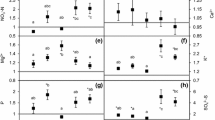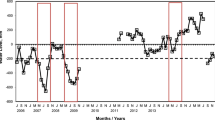Abstract
The central grassland region of the United States encompasses major gradients in temperature and precipitation that determine the distribution of plant life forms, which in turn may influence key ecosystem processes such as nutrient cycling and soil organic matter dynamics. One such gradient is the threefold increase in precipitation from the eastern Colorado shortgrass-steppe, in the rain shadow of the Rocky Mountains, to the tallgrass prairie in eastern Kansas. We investigated the relative roles of plant species and plant cover in influencing soil C and N cycling in three sites along this gradient. Plant cover (i.e., the presence or absence of an individual plant) was relatively more important than plant species in explaining variability in soil properties at the dry site, the Central Plains Experimental Range in␣northeastern Colorado. However, plant species explained relatively more of the variability in soil properties than did plant cover at the two wetter sites, Hays and Konza, in central and eastern Kansas. The wetter sites had more continuous plant cover, resulting in less plant-cover-induced variation in soil C and N, than did the dry site, which had distinct patches of bare ground. Plant species at the wetter sites had higher and more variable levels of tissue C:N than plant species at the dry site, due to both within species changes and changes in species composition. Aboveground tissue C:N was better correlated with net nitrogen mineralization rates at the wet sites than the dry site. Thus, tissue chemistry appears to exert more control on nitrogen dynamics at the wet than the dry sites. The results suggest that plant species traits that are relevant to nutrient cycling (e.g., tissue C:N ratios, spatial patterns, productivity) reflect environmental limitations as well as species' physiological potentials. Furthermore, a dominant environmental driver such as precipitation may ameliorate or exaggerate the importance of individual species traits for nutrient cycling.
Similar content being viewed by others
Author information
Authors and Affiliations
Additional information
Received: 11 July 1996 / Accepted: 5 December 1996
Rights and permissions
About this article
Cite this article
Vinton, M., Burke, I. Contingent effects of plant species on soils along a regional moisture gradient in the Great Plains. Oecologia 110, 393–402 (1997). https://doi.org/10.1007/s004420050174
Issue Date:
DOI: https://doi.org/10.1007/s004420050174




